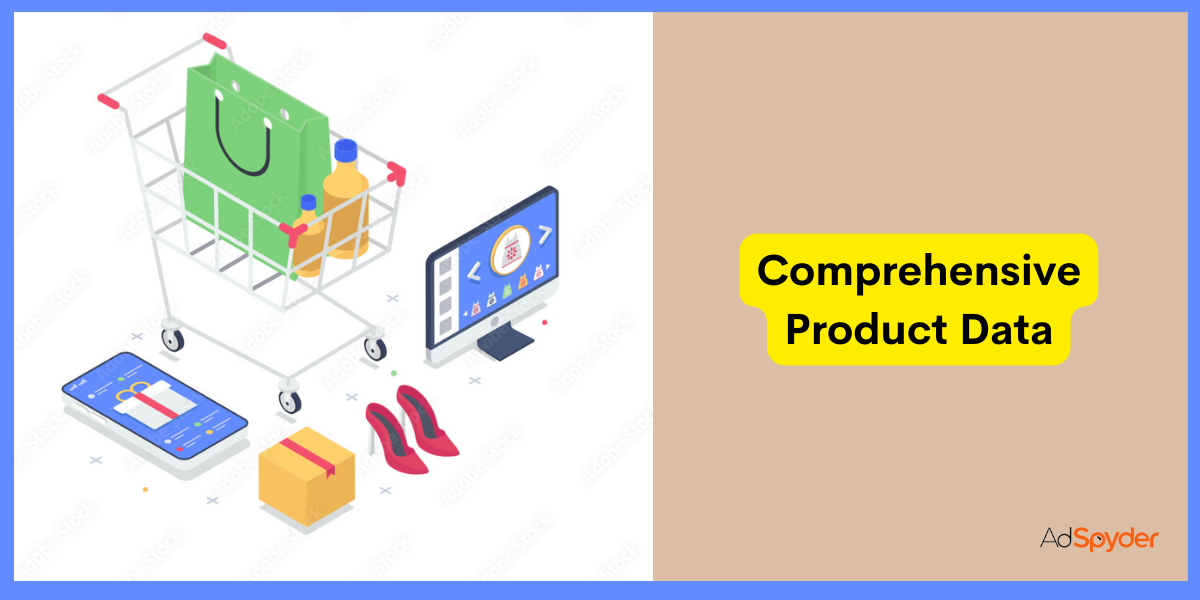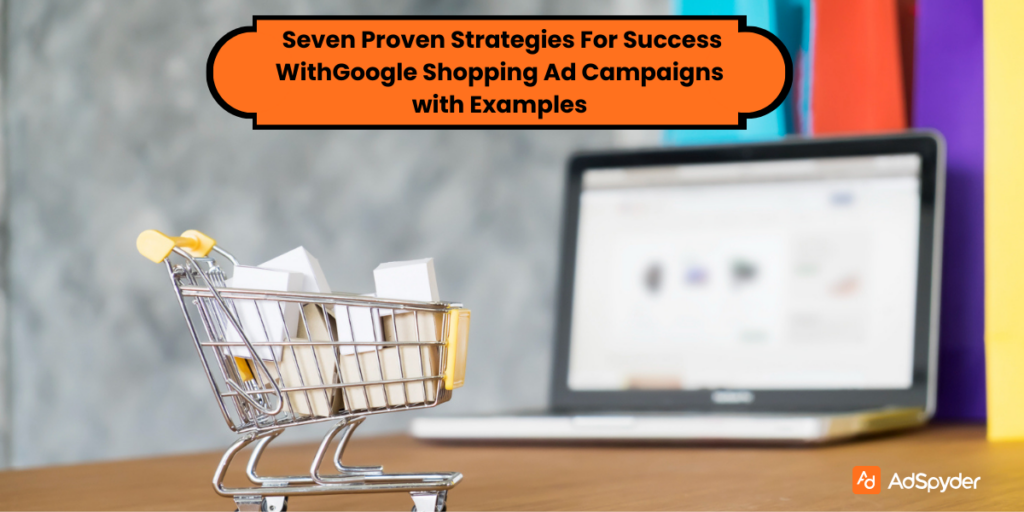Struggling to make your mark with Google Shopping ads? You’re not alone. Many find it challenging to navigate the competitive landscape of online retail advertising. This article dives into seven proven strategies that can elevate your Seven Google Shopping campaign strategies, complete with real-world examples. Ready to boost those sales?
Ready to Elevate your Marketing Strategy?
Navigating Google Shopping Ads

Getting around Google Shopping Ads starts with preparation. You need a strong plan that includes optimizing your product listings and making smart bids. Think about what makes your products stand out, and then use those details to attract clicks.
- This process involves choosing the right keywords and making sure your ads show up for those terms. Using tools like the Google Merchant Center helps you manage how your products are listed.
- Optimizing search queries and testing different bid strategies keep you ahead in the game. Segmenting products by type allows for more targeted advertising, which can lead to better results.
Implementing proper bid adjustments based on performance data ensures that your budget is spent efficiently, maximizing return on investment (ROI). Remember, success with Google Shopping Ads means always looking for ways to improve–whether it’s tweaking ad groups or refining product feeds for higher quality scores.
Unpacking the Essence of Google Product Listing Ads (PLAs)
Moving from the broad view of Google Shopping Ads, let’s dive into the details of Google Product Listing Ads (PLAs). These are not just any ads—they show your products directly to people searching for them.
- Picture this: someone looks for sneakers, and there they are, your sneakers, right on their screen with a picture, price, and store name. It’s a direct way to grab attention. PLAs stand out because they’re more than text; each ad includes vital information like brand name and cost.
- This setup makes it easier for buyers to make quick decisions.
- For businesses aiming to boost their online presence, using PLAs is like putting your product on the front shelf of a digital store. You give potential customers everything they need at first glance: what it looks like and how much it costs.
- Plus, these ads pop up across Google searches and Google Shopping—a massive audience awaits! Learning how these ads work can truly change the game by increasing click-through rates and conversion rates.
- Key here? Your product feed needs to be spot-on—accurate titles, descriptions, and images mean better visibility in search results.
The Remarkable Impact of Google Shopping Campaigns on Retail
Understanding Google Product Ads sets the stage for appreciating the power of Google Shopping campaigns in retail. These campaigns have reshaped how retailers reach their audience online, turning clicks into customers more effectively.
- Retailers leveraging these ads see a significant boost in ROI and conversions, thanks to optimized strategies that grab shopper attention. Ads featuring product ratings, for instance, can push click-through rates up by as much as 10%.
- This shows just how critical Google Shopping ads are for increasing visibility and driving sales in a crowded digital marketplace.
- Retailers across the board find value in fine-tuning their ad campaigns to match consumer searches better. With tools like feed optimization and strategic bidding, getting products in front of interested buyers has never been easier or more efficient.
The results speak volumes—improved online presence, higher sales figures, and stronger customer connections. In essence, Google Shopping Campaigns offer retailers a direct line to highlight their products at the moment consumers are ready to buy.
Best Practice 1: Comprehensive Product Data

Having detailed product data is key to Google Shopping campaign success. This means including all the info—prices, photos, and descriptions—that shoppers need to make a decision.
- Clear and complete details can boost your ad’s performance by helping it show up in the right searches.
- Photos must be high-quality and relevant because they catch the shopper’s eye first. Accurate descriptions help too, as they let customers know exactly what they’re getting.
- Next up is making sure your product titles and descriptions are top-notch, which plays a big role in attracting customers.
Crafting High-Quality Product Titles and Descriptions
Crafting top-notch product titles and descriptions is crucial. You must highlight key features and benefits to make your product pop.
- Include brand, size, and color in the title for clarity. This balance grabs attention.
- Descriptions should be rich with keywords that matter to your target audience, even though Google Shopping doesn’t use them for relevancy. This strategy boosts visibility.
- Always pair your words with high-quality images to show off what you’re selling clearly. Using Google Merchant Center promotions can further enhance your listings.
Remember, clear and detailed information paired with eye-catching images makes all the difference in catching a shopper’s eye and turning clicks into customers.
The landing page should also be in line with your product listings. Create content marketing around your products to boost your visibility. Use press releases for PR marketing, for top of the line products and videos for product previews.
Example: An Exceptional Product Listing in Google Shopping
Taking the steps from crafting high-quality product titles and descriptions, let’s dive into how an exemplary product listing looks in Google Shopping. Imagine a brand that sells stylish sneakers.
- They use clear, crisp images showing the shoe from different angles—top, side, front, and even on someone’s feet.
- Each photo is bright and detailed, making it easy for shoppers to see the quality of the material and design.
- The title “Durable Street Style Sneakers – Multiple Colors” catches attention right away. The description goes further to highlight key features: breathable fabric, various sizes available, and waterproof exterior…all targeted at answering potential questions upfront.
- This brand also smartly includes positive customer reviews directly in their listing.
This approach builds trust with new customers browsing through Google Shopping Ads. Additionally, they make sure all relevant keywords like “comfortable,” “fashionable,” “durable,” are part of their product feed optimization strategy. This ensures their ad appears more frequently in relevant searches—helping them stand out amidst a sea of competitors without overwhelming potential buyers with too much text or unnecessary jargon.
Best Practice 2: Impeccable Feed Optimization

After seeing how a great product listing makes a difference, let’s dive into impeccable feed optimization.
- This step is key for your ads to perform well. Your Google Shopping feed needs careful attention—each detail matters. From clear images to precise product categories, everything must be spot on.
- Adding relevant keywords in titles and descriptions helps buyers find what they need quickly.
- Optimizing your feed also means regularly updating inventory and pricing information.
- Use high-quality images and detailed product descriptions to stand out.
Remember, avoiding errors and keeping data fresh boosts the chances of success against competitors. It’s not just about making products look good; it’s ensuring they’re seen by the right people at the right time.
Key Tactics for an Optimized Product Feed
Creating a perfect data feed sets the stage for a Google Shopping campaign’s success. Here are essential tactics to optimize your product feed:
- Use high-quality images: Consumers click more on clear, attractive photos. Ensure each product has a high-resolution image.
- Include detailed product titles: Blend being concise with descriptive. Incorporate brand, size, color, and unique features.
- Write compelling descriptions: They should highlight key benefits and features of the product, engaging potential buyers.
- Regularly update your feed: Stock levels, prices, and products change. Keep your feed current to avoid customer disappointment.
Example: A Well-Structured Product Feed in Action
An online bookstore has nailed their product feed for Google Shopping ads.
- They’ve sorted books by genre, author, and publication date in their database. This meticulous organization lets them target ads precisely.
- For example, they can show the newest science fiction releases to a sci-fi fan looking online. Their ad’s success lies in matching book lovers with genres they adore.
- This approach doesn’t just boost ad effectiveness; it also increases sales chances. The bookstore’s smart use of data ensures that customers see books they’re likely to buy.
- It’s a win-win – shoppers find great reads easily, and the bookstore sells more books efficiently.
Best Practice 3: Strategic Bidding and Budget Management
Managing your budget wisely is key to getting the most out of Google Shopping ads.
- Choosing the right bidding strategy—like target return on ad spend (ROAS) or enhanced cost-per-click (CPC)—helps you meet your sales and visibility goals without overspending.
- It’s all about finding what works best for your business and tweaking it for optimum results. You should always be ready to adjust bids and budgets based on performance data, ensuring that every dollar spent pushes you closer to your targets.
- Effective budget management also involves analyzing past performances to predict future needs. This enables advertisers to allocate funds more efficiently across campaigns, focusing on those with the highest potential for returns.
- Keep an eye on conversion rates, revenue, and profit metrics—they’ll tell you if your strategies are working as expected.
Showcasing products in Google Shopping becomes even more dynamic with Showcase Shopping Ads—expanding opportunities for brands in digital marketing arenas.
Effective Bidding Strategies for Google Shopping Ads
Automated bidding takes the guesswork out of setting bids for your Google Shopping ads. It adjusts your bids in real time, aiming to get the most clicks or conversions at the best price.
- This method is a solid choice because it uses advanced algorithms to predict how different bid amounts might impact your sales or website visits. Testing various bid strategies is also key — not all approaches work the same for every business.
- Some might find success with cost per click (CPC) while others do better focusing on return on ad spend (ROAS). Experimenting helps you discover which strategy boosts your performance.
- Set budgets wisely to avoid running out of funds mid-campaign. Use tools like CPC and ROAS metrics to guide how you allocate money toward high-performing ads or keywords. Smart bidding can further refine this process by optimizing bids based on set goals, like maximizing conversions within a certain budget limit.
- Lastly, keep an eye on negative keywords and add them as needed; they help filter out unwanted traffic, ensuring that only potential buyers see your ads. This tactic saves money and improves overall campaign efficiency.
Example: Budget Optimization in a Google Shopping Campaign
A fitness gear company decided to shift its Google Shopping campaign funds toward trending products.
- They noticed a spike in the search for eco-friendly yoga mats. The team then allocated more budget to these mats’ ads, reducing spend on less popular items.
- This move led to higher visibility and sales for the yoga mats, showcasing wise budget use.
- Next, they analyzed data from their campaign performance. Insights showed certain times of day brought more clicks and conversions for specific items.
- Adjusting ad schedules to match high traffic times further optimized spending, ensuring ads reached potential buyers when they were most likely online.
Now, let’s dive into how showcasing with Showcase Shopping Ads can make a difference.
Best Practice 4: Showcasing with Showcase Shopping Ads
Showcase Shopping ads are perfect for retailers with big catalogs.
- They let you use great images and storytelling in your product descriptions to grab attention.
- This way, you highlight more of what you offer in a neat, eye-catching package. It’s about making sure customers see the best of your collection in one go.
- Using high-quality images makes these ads pop. You can tell a compelling story about your products, helping shoppers understand what sets them apart.
Next, we’ll explore dynamic remarketing strategies to keep drawing customers back.
Maximizing Impact with Google Shopping Showcase Ads
- Google Shopping Showcase Ads lets businesses group a collection of related products and present them under one ad. This is perfect for showing off product ranges or themes to potential buyers.
- Think about creating ads that spotlight your best-selling items or seasonal collections. You’ll grab attention by highlighting choices, not just single products. Use high-quality images and clear, enticing descriptions to make these ads pop.
- Optimization here is key—make sure you’re using the right keywords and targeting settings to reach your ideal customers. Track performance with analytics tools and tweak as needed.
- These showcase ads can significantly boost visibility and clicks when done right, leading to higher conversions and sales. Remember, showcasing your range gives shoppers a window into what you offer, making it easier for them to find exactly what they want.
Example: Success Story with Showcase Shopping Ads
A company specializing in outdoor gear took a smart step with Showcase Shopping Ads. They grouped products like hiking boots, waterproof jackets, and lightweight backpacks under the theme “Adventure Essentials.” This strategy captured the attention of adventure lovers quickly.
Shoppers could easily find everything they needed for their next trip in one place. Sales soared as customers appreciated how these ads made shopping simpler and more inspiring. This success story highlights the power of well-thought-out Showcase Shopping Ads. The company’s sales increased because they presented their products in a way that resonated with their target market’s lifestyle. Using attractive images and clear, compelling descriptions, they turned browsers into buyers by making it easy to imagine how those products could enhance their adventures.
Best Practice 5: Dynamic Remarketing for Higher Conversions
After exploring the success of showcase shopping ads, dynamic remarketing stands out as a key strategy for boosting conversions in Google Shopping campaigns. This method re-engages visitors who have shown interest in your products but left without making a purchase.
- By displaying personalized ads based on their previous interactions, dynamic remarketing encourages them to return and complete the sale.
- This approach not only increases sales but also enhances customer experiences by reminding them about items they like.
- It’s essential to craft specific ads targeting different segments of visitors—those who viewed product pages, added items to a cart, or even those who just browsed your site.
Implementing target ROAS bidding helps optimize spending towards users most likely to convert, ensuring better returns from your ad campaign.
Leveraging Dynamic Remarketing in Google Shopping
Dynamic remarketing in Google Shopping lets you reconnect with past site visitors:
- You can show them tailored ads based on what parts of your website they checked out before. This method is powerful because it speaks directly to their interests, making them more likely to buy something from you again.
- Using images that catch the eye and clear messages improves your chances even further.
- To set this up right, focus on creating ads that match what people looked at or added to their cart but didn’t buy.
- Note that for remarketing strategies, it becomes important to assign relevant contributions to both the original marketing and remarketing campaign. For example, in a video marketing campaign and shopping campaign as remarketing, ROI for video marketing and shopping campaign should be considered for actual ROI.
Remember, there are the above strategies to make Google Shopping ads work harder for you, including Dynamic Remarketing.
Example: Remarketing Excellence in Shopping Ads
An online electronics shop mastered remarketing by targeting customers who left items in their carts.
- They made clever use of ads to show these specific products again to interested but hesitant buyers.
- To sweeten the deal, they offered limited-time discounts or free shipping. This approach directly addressed customer hesitation and provided a strong incentive to complete their purchases.
- Using this strategy, the store saw an increase in conversion rates. The well-timed ads reminded customers of what they had considered buying and motivated them with enticing offers.
Such targeted remarketing became a key tool for the store, boosting sales effectively without increasing their advertising spending significantly.
Best Practice 6: Location-Based Store Visit Ads
Location-based store visit ads are a powerhouse in bridging online and offline shopping experiences.
- Google uses phone location history to check if someone visits your store after clicking an ad. This is great for figuring out how effective your online ads are in bringing customers into your physical store.
- You can boost this effect by increasing bids for shoppers nearby during store hours, making sure you’re catching their attention when they’re most likely to drop by.
- Adding options like store pickup or online pickup in-store invites even more foot traffic. It shows that you’re flexible and mindful of customer convenience, encouraging them to choose your shop both online and off.
Remember, these strategies hinge on understanding consumer behavior—knowing when they shop helps tailor ads that speak directly to them at the right moment.
Using Google Ads for Store Visits in Shopping Campaigns
Google Ads lets you target customers who are likely to visit your store. With smart bidding, you can:
- Focus on getting more people through your door by optimizing for store visits.
- This works well for shopping campaigns where visuals, like product images and prices, help grab attention.
- It’s a smart move for physical stores that want to increase foot traffic using online ads.
- To set up ads for store visits, choose strategies that fit with Google Shopping and Performance Max campaigns. You’re showing potential customers what they can buy before they even step into your store.
- Remember, every ad showcases a product’s picture, title, price, and retailer info—making it easier for shoppers to make quick decisions.
Example: Store Visits Amplified with Shopping Ads
Turning our focus on applications, a retail chain implemented shopping ads to boost store visits significantly.
- These ads highlighted the convenience of picking up online orders in-store.
- The campaign used clear images and straightforward messages about easy pickup options, which encouraged more customers to click through. This strategy not only drove online traffic but also increased physical foot traffic as people came in to collect their orders.
- Customers found it simple to order ahead and appreciated saving time by skipping the shopping aisles. As a result, both online and in-store purchases saw a rise.
- The ads showcased popular products available for quick pickup, making it tempting for buyers to add more items to their carts.
This approach seamlessly blends the ease of online shopping with the immediate satisfaction of getting products in person, proving that smart ad campaigns can bridge the gap between digital convenience and traditional retail benefits.
Best Practice 7: Continual Monitoring and Adaptation
Keep a close eye on your Google Shopping Ads’ performance. This means regularly checking how they are doing using tools like Google Analytics. You want to see what’s working and what’s not. From this, you learn and make changes to do better next time. It is like keeping your ads fit—always ready for the race. Use the insights from monitoring to tweak your campaigns. Maybe some keywords are attracting too many clicks but no buys? Add them as negative keywords to save money. Noticed a product suddenly trending? Maybe push it more in ads. Also keep in mind the restrictions and prohibitions for running Google Shopping ads. For example, if you are an online gambling website, note the changes made to the responsible gambling ads policy frequently.
Small changes based on data can lead to big wins over time, helping you use your budget wisely and get more from every dollar spent.
Key Metrics to Monitor and Enhance Google Shopping Ad Performance
To boost your Google Shopping ad performance, you need to pay attention to certain key metrics. These indicators give you insights into what’s working and highlight areas that need improvement. Here’s a rundown of crucial data points to keep an eye on:
- Click-Through Rate (CTR) – This shows the percentage of people who click on your ad after seeing it. A high CTR means your ad is relevant and appealing to your target audience.
- Conversion Rate – Indicates how many clicks on your ad lead to a purchase. It helps you understand if your ads are effective in turning interest into sales.
- Return On Ad Spend (ROAS) – This metric tells you how much revenue you’re making for every dollar spent on ads. It’s key for measuring the profitability of your campaigns.
- Cost Per Click (CPC) – Tracks how much you pay each time someone clicks on your ad. Keeping an eye on CPC helps manage your budget efficiently.
- Cost Per Acquisition (CPA) – Measures the cost of acquiring a new customer through your ads. A lower CPA means you’re spending less for each conversion, which is good for profits.
- Quality of Landing Pages – Evaluate how well your landing pages perform in terms of keeping visitors engaged and encouraging them to make a purchase.
- Campaign Performance Data – Reviews overall campaign success, identifying which products or ads drive the most sales and which might be underperforming.
Example: Data-Driven Optimization in a Shopping Campaign
A sports store used their sales records smartly to tweak their Google Shopping ads. They spotted a trend — every spring, customers bought more hiking gear. Using this insight, they focused their ads on hiking boots and gear during these months. This change made the ads more relevant and boosted sales. They didn’t stop there. The store also adjusted bids for those hiking products, spending more on what sold well. They kept an eye on how each ad performed and quickly changed anything that wasn’t working. This careful watch helped them spend their budget wisely and get more people to click on their ads.
Common Mistakes in Google Shopping Campaigns
Here are a few mistakes to avoid while running your Google Shopping Campaigns:
- Poor Product Feed Optimization: Incomplete or inaccurate product data can hurt visibility. It can also lead to confusion among your shoppers. Ensure titles, descriptions, and images are optimized with relevant keywords.
- Ignoring Negative Keywords: Failing to add negative keywords leads to irrelevant traffic and wasted ad spend. It also brings traffic among people who are not actually looking for your brand or product. Regularly update your negative keyword list.
- Overlooking Bid Adjustments: Not adjusting bids based on device, location, or time of day can result in inefficient spending. Optimize bids according to performance data. Kepp up to date with the bidding metrics and fine tune it to suit your goals.
- Neglecting Product Segmentation: Failing to segment products by category, price, or performance makes it hard to apply targeted strategies. Break down your product catalog into smaller, relevant groups for better bid management and performance tracking. It also helps a lot for personalisation of ad messaging.
- Inadequate Budget Allocation: Not properly distributing your budget across high-performing products or campaigns can lead to missed opportunities. Monitor your budget and adjust spending to prioritize top-converting items. You also can reduce your spending to low conversion
- Ignoring Seasonal Trends: Failing to capitalize on seasonal demand spikes means missing out on sales. This is one of the times when your offerings can sell like crazy. Adjust bids and tailor your product offerings during peak shopping seasons like Black Friday or the holiday period.
- Not Using Performance Data: Many advertisers fail to analyze performance data from Google Merchant Center and Google Ads to refine campaigns. Use insights to adjust bids, optimize product listings, and identify which products drive the best ROI.
Conclusion
Mastering Google Shopping Ads is a game-changer for e-commerce. From crafting perfect product listings to strategic bidding and on-point optimization, these seven strategies pave the way. Real-life examples bring lessons home, showing what works. Dive into this guide, apply the insights, and watch your campaigns flourish. Success in Google Shopping doesn’t just happen—it’s built with smart tactics and continuous improvement.




